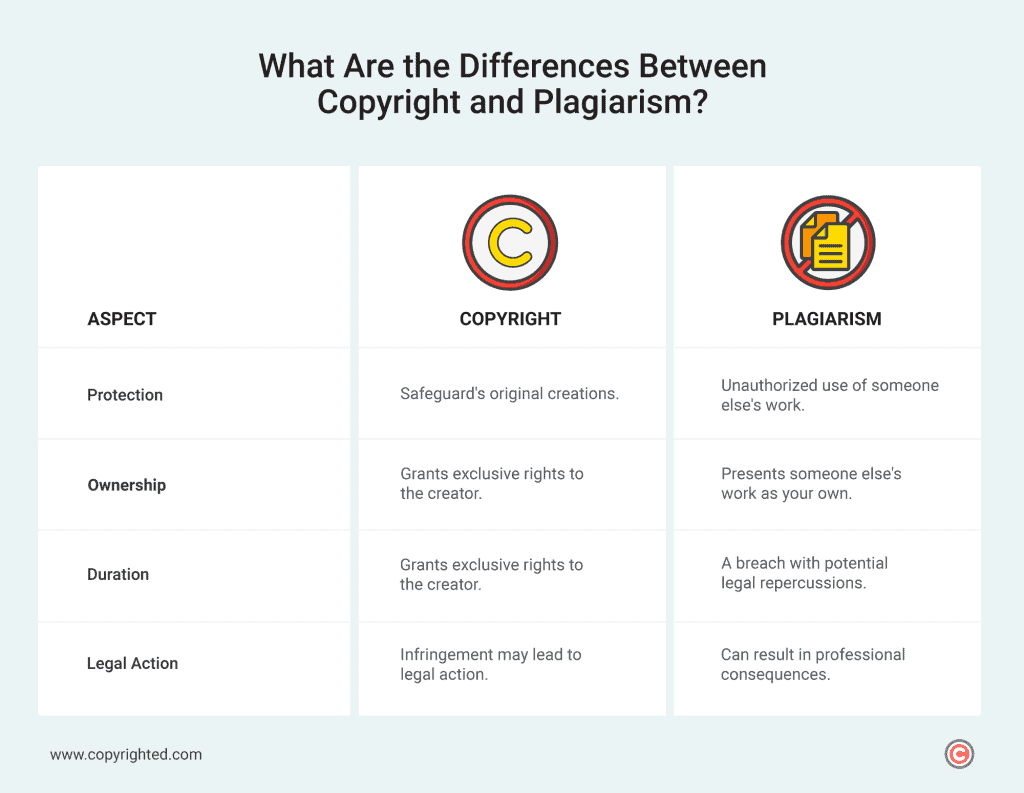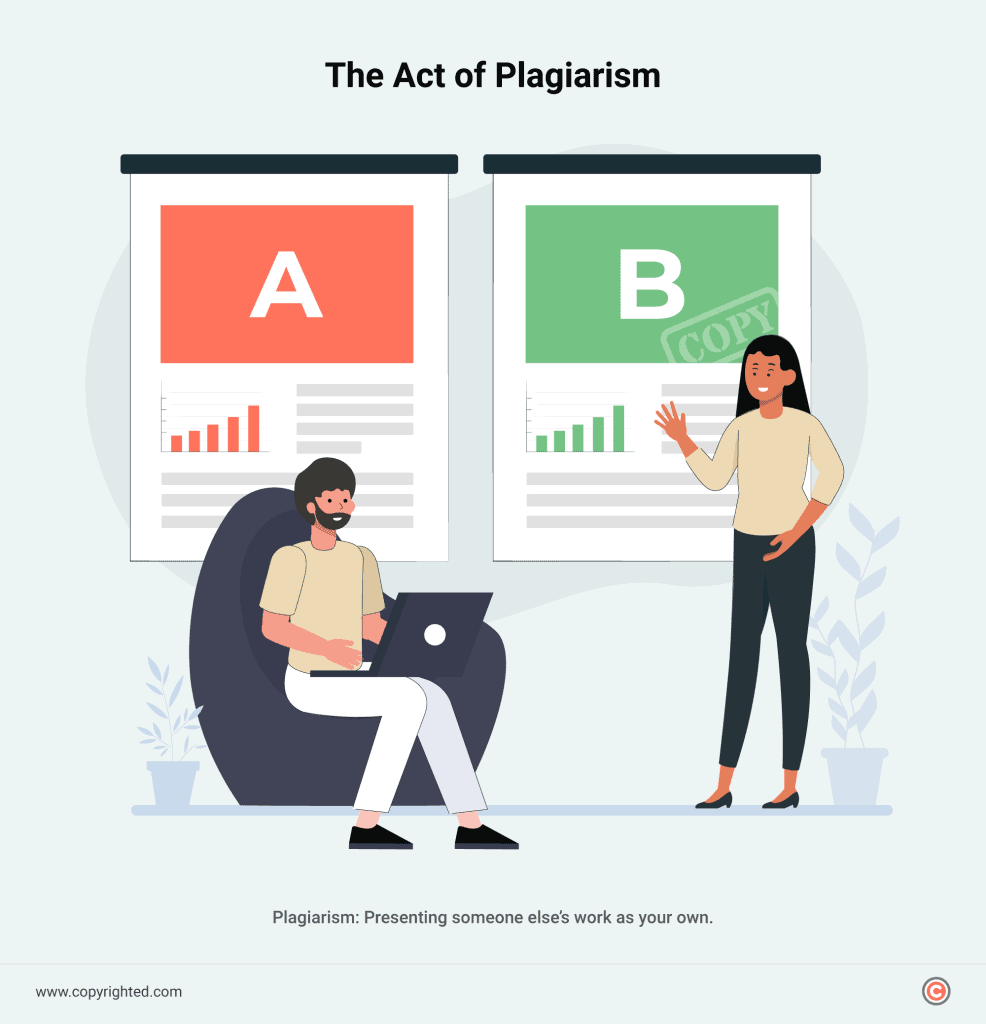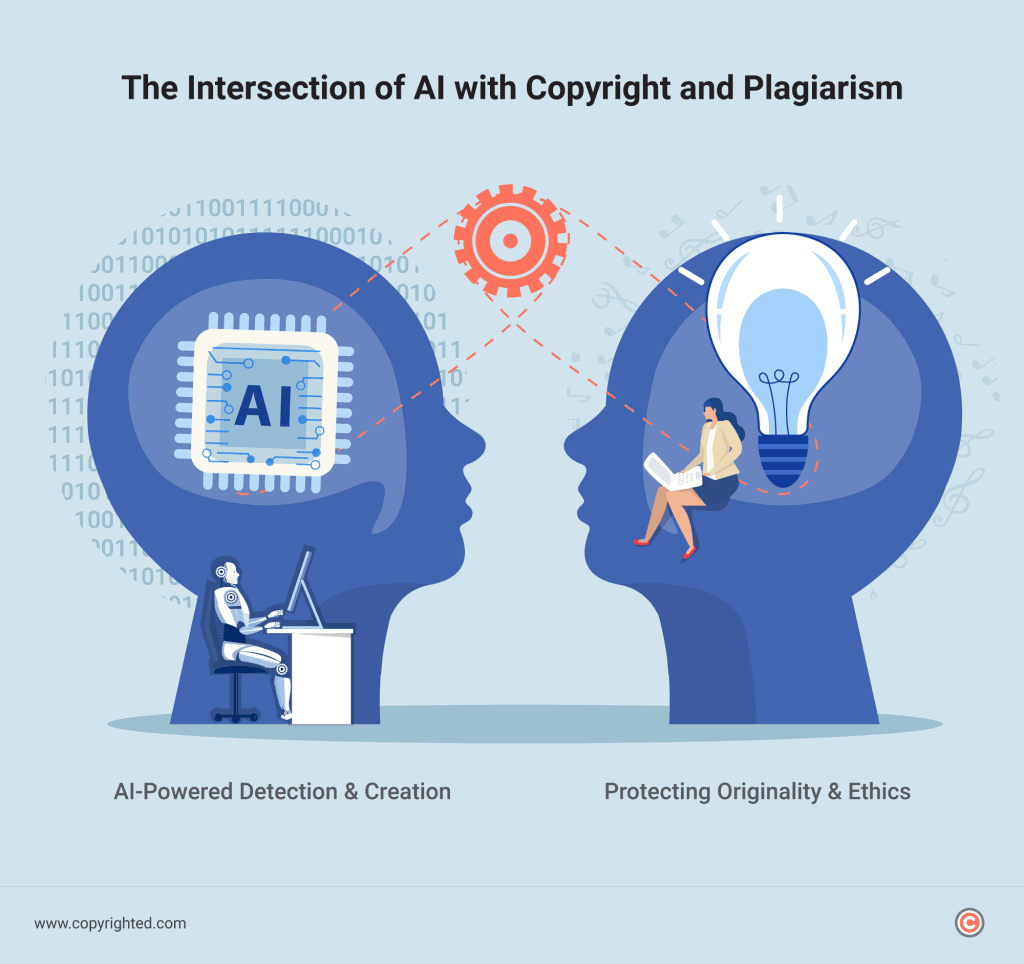In the world of content creation, dealing with plagiarism and copyright infringement issues can happen to anyone. This is especially true in today’s digital age, where it’s easy to take something from the internet, make small changes, and claim it as your own.
Although plagiarism and copyright infringement are different concepts, people often get confused as both involve presenting someone else’s work as your own. Whether you’re using the internet or the library for research, understanding copyright and plagiarism is essential to steer clear of trouble.
This guide breaks down the differences between the two, explores their nuances, discusses consequences, and provides practical tips to avoid them. We’ll also touch briefly on how AI relates to copyright and plagiarism, offering a forward-looking perspective on these critical issues.
- Copyright is a legal concept designed to protect the rights of creators for their original works.
- Plagiarism is the act of presenting someone else’s ideas, words, or work as your own without giving them proper credit.
- It’s important to always provide accurate and complete citations for any information or ideas borrowed from other sources.
Table of Contents
What Are The Differences Between Copyright and Plagiarism?
When you create something, whether it’s an article, image, or video, copyright automatically protects it. Picture it as a safety net that grants you exclusive rights over your creation.
These rights, however, are not eternal and they only offer protection for a specific timeframe. After that, your work enters the public domain for everyone to use.
On the flip side, there’s plagiarism, the less desirable counterpart. Plagiarism occurs when someone presents another’s work as their own.
Not only is plagiarism frowned upon in the digital community, but it can also lead to legal consequences. In essence, plagiarism undermines the principles of authenticity and originality.
To make the distinctions clear, let’s examine the key differences through a comparison table:

Copyright serves as more than mere rules, it acts as a tool, granting you authority over the future of your content. On the other hand, plagiarism is like a shortcut that inevitably leads to a professional dead end.
Steer clear of plagiarism, and allow your work to stand as a testament to your professional honesty. Keep it genuine, and your professional integrity will resonate strongly.
What is Copyright?
Copyright is a legal concept designed to protect the rights of creators for their original works. It provides creators with exclusive rights to control the use, distribution, and reproduction of their creations.
Copyright helps with creativity, encourages new ideas, and makes sure people who put effort into making things get to keep their rights.
In the United States, the legal foundation for copyright is deeply rooted in the U.S. Constitution, which empowers Congress to grant authors and inventors exclusive rights for a limited time. The details of copyright law are further outlined in the Copyright Act, providing a comprehensive framework for the protection of various forms of creative expression.
Balancing the rights of creators and the public is essential in copyright. Instead of being like an impenetrable fortress, copyright aims for a fair middle ground.
One important thing to note is that copyright doesn’t last forever. It has a time limit, so creative works don’t stay under control forever.
This intentional limit means that eventually, these works become available to everyone in the public domain. It’s like opening the door to let society freely enjoy and benefit from these creations.
The main idea behind this is to find a balance where creators are protected during their active years, giving them credit for their hard work and promoting continuous innovation. As time goes on, their works eventually become available to the public, becoming part of our shared cultural heritage.
This process acknowledges two goals: supporting creativity and making sure the benefits of creativity are shared with everyone.
Now, let’s unpack the various types of works that fall under the protective umbrella of copyright, each with its considerations.
Literary Works
This category blankets a wide array of written content, including books, articles, and textual compositions. Authors wield copyright protection here, securing their exclusive rights to reproduce, distribute, and showcase their written creations.
Visual Arts
Moving to the visual arts, this category spans paintings, drawings, and photographs. Visual artists enjoy copyright protection, safeguarding their right to manage the reproduction and public display of their visual expressions, preserving the authenticity of their creative output.
Performing Arts
Next is the performing arts, which includes both live and recorded performances. This broad category ensures performers and creators retain control over the reproduction and public dissemination of their live or recorded acts, emphasizing the significance of their creative contributions.
Sound Recordings
Sound recordings, involving the protection of recorded sounds and music, form another important facet of copyright. Musicians and record producers find strength in copyright protection, allowing them to govern the use and distribution of their recorded musical creations.
Architectural Works
Lastly, architectural works cover the design and structure of buildings. Architects, as copyright holders, maintain authority over the reproduction and distribution of their architectural designs, affirming the respect owed to their creative pursuits.
What is Plagiarism?

Plagiarism is the act of presenting someone else’s ideas, words, or work as your own without giving them proper credit.
Plagiarism is a breach of academic and ethical integrity. This includes various forms such as direct copying, paraphrasing without attribution, mosaic or patchwork plagiarism, self-plagiarism, and even accidental unintentional plagiarism.
Understanding and avoiding plagiarism is important in maintaining honesty and upholding ethical standards in academic and professional settings.
Now, let’s explore the various forms of plagiarism to understand its implications.
Copy-and-Paste Plagiarism
This is the straightforward act of copying someone else’s work and presenting it as your own. It can involve entire paragraphs, sentences, or even just a few words.
Paraphrasing Plagiarism
Changing the words of a source while retaining the original meaning is still considered plagiarism if proper credit is not given. It’s not just about swapping words but understanding and presenting the ideas in your own unique way.
Mosaic or Patchwork Plagiarism
This sneaky form involves combining bits and pieces from various sources to create a seemingly original piece. It can be a mix of copied text and slightly modified content, creating a mosaic of information without proper attribution.
Self-Plagiarism
Self-plagiarism involves the reuse of your previously published content or portions of it, presented as new and original work. While not illegal, self-plagiarism is considered unprofessional and unethical and includes actions like submitting entire papers that have been previously published.
Accidental Unintentional Plagiarism
Unintentional plagiarism occurs when proper citation practices are not followed due to a lack of understanding rather than an intentional effort to deceive. It’s important to educate oneself on proper citation methods to avoid accidental unintentional plagiarism.
How Do You Prevent Copyright and Plagiarism Violations?
Maintaining integrity in content creation involves being proactive in preventing both copyright infringement and plagiarism. Here are practical tips and tools to ensure you steer clear of both.
How to Avoid Infringing Copyright?
Before sharing prevention tips, let’s address a common question: Is infringing copyright the same as theft? While copyright infringement vs theft share similarities in depriving the owner of the benefits of their creation, they differ in legal terms.
Copyright infringement pertains specifically to the unauthorized use of copyrighted material, whereas theft typically involves physical deprivation of property.
Now, let’s explore ways to sidestep copyright infringement:
- Understand Fair Use: Familiarize yourself with fair use guidelines and respect the limitations and exceptions for using copyrighted material.
- Use Licensed Content: Choose content with proper licensing, ensuring you have the right to use and share it in your work.
- Seek Permission: When uncertain, obtain explicit permission from the copyright owner before using their material.
- Utilize Creative Commons Licenses: Leverage content under Creative Commons licenses, which provide clear guidelines for usage.
- Explore Public Domain Works: Incorporate works that are in the public domain, as they are free from copyright restrictions.
How to Avoid Committing Plagiarism?
Now, moving to plagiarism prevention, let’s ensure that the ideas and words you use are rightfully attributed to their origin. Here’s a guide to avoiding plagiarism:
- Proper Citation: Always provide accurate and complete citations for any information or ideas borrowed from other sources.
- Effective Paraphrasing: Practice effective paraphrasing to convey ideas in your own words while retaining the original meaning.
- Use Plagiarism Detection Tools: Employ plagiarism detection tools to check your work for potential instances of unintentional plagiarism.
- Educate Yourself: Stay informed about the principles of plagiarism. Many educational institutions offer resources and tutorials to help you understand and avoid plagiarism.
By adhering to these preventive measures, you can ensure your creative and academic endeavors are both ethically sound and legally compliant.
How Do You Resolve Copyright and Plagiarism Violations?
Encountering copyright and plagiarism violations requires a thoughtful and strategic approach to address the issues responsibly. Here are steps and strategies for resolving these matters while considering both legal and ethical considerations.
Resolving Copyright Violations
- Cease Unauthorized Use: Immediately stop using the copyrighted material without proper authorization. Stopping unauthorized use is the first step toward rectification.
- Open Communication: If possible, reach out to the copyright owner or creator. Explain the situation, acknowledge the infringement, and express a commitment to resolving the issue.
- Obtain Permission: Seek permission from the copyright owner for the continued use of the material. This may involve negotiating a licensing agreement or obtaining explicit consent.
- Comply with DMCA Takedown Notices: If a Digital Millennium Copyright Act (DMCA) takedown notice has been issued, comply with the request promptly. Remove the infringing content from online platforms to avoid legal consequences.
- Provide Proper Attribution: If attribution was lacking or incorrect, rectify this by providing proper credit to the original creator. Acknowledging the source is an essential step in addressing copyright violations.
Resolving Plagiarism Violations
- Acknowledge the Plagiarism: Acknowledge the act of plagiarism. Understand that it is a serious ethical breach and take responsibility for the improper use of someone else’s work.
- Offer Open Communication: Offer to communicate openly with the affected parties. Explain the circumstances, apologize for the plagiarism, and express a commitment to resolving the concern.
- Rectify the Issue: Immediately rectify the issue by providing proper attribution to the original source. Clearly indicate where the borrowed material begins and ends.
- Learn and Educate: Educate yourself about proper citation practices and academic integrity. Use the experience as an opportunity to grow and ensure that future work adheres to ethical standards.
- Follow Institutional Procedures: In an academic setting, follow the established procedures outlined by the institution for addressing plagiarism. This may involve reporting the incident to professors, academic boards, or other relevant authorities.
- Face Academic Consequences: If there are academic consequences, such as failing grades, work collaboratively with instructors or academic advisors. Follow any recommended steps for academic redemption.
For both copyright infringement and plagiarism issues, if legal consequences are looming, consult with legal professionals to understand the potential implications and explore options for resolution.
Taking immediate action, demonstrating genuine remorse, and actively working to resolve the violation are essential steps if you find yourself in violation of copyright or guilty of plagiarism. Open communication and a commitment to learning from the experience can also contribute to a more constructive resolution.
Consequences of Copyright and Plagiarism Violations
Understanding the consequences of copyright infringement and plagiarism is essential to promoting ethical behavior and upholding legal standards in creative and academic endeavors. Adhering to proper practices not only protects individual reputations but also contributes to a culture of integrity and respect for intellectual property.
Consequences of Copyright Infringement
Copyright infringement carries significant legal implications. Individuals or entities found guilty of this offense may face financial penalties, including fines and damages awarded to the copyright owner.
Courts have the authority to issue injunctions, restraining the infringing party from further using or distributing the copyrighted material without proper authorization. In severe cases, copyright infringement can escalate to criminal charges, potentially leading to imprisonment for the violators.
Additionally, online platforms may swiftly respond to a Digital Millennium Copyright Act (DMCA) takedown notice by removing infringing content, thereby impacting the violator’s online presence.
These legal consequences emphasize the importance of respecting intellectual property rights and adhering to copyright laws to avoid severe penalties and legal actions.
Consequences of Plagiarism
Plagiarism has multifaceted implications, primarily rooted in ethical, academic, and professional settings.
Ethically, engaging in plagiarism can inflict substantial damage on one’s personal and professional reputation. It destroys trust and gives rise to questions about an individual’s integrity.
Plagiarism also carries severe consequences within academic settings, including the potential for failure in assignments, and courses, or even expulsion from educational institutions. Academic disciplinary actions, such as notations on transcripts, further underscore the gravity of this ethical breach and can leave lasting marks on an individual’s academic record.
Committing plagiarism can hinder your professional progress, as employers may view it as a significant breach of trust. This perception could result in job loss or missed career opportunities, stopping your growth in your chosen field.
Moreover, in professions with strict ethical standards, plagiarism might lead to legal action or professional penalties.
What is the Impact of AI on Copyright and Plagiarism?

The integration of Artificial Intelligence (AI) into the realms of copyright and plagiarism has ushered in transformative changes, showcasing a dual-edged nature that both challenges and enhances the landscape.
Let’s get into the finer details of this matter.
Detection of Plagiarism
AI in plagiarism detection has significantly improved efficiency and accuracy. These tools analyze large amounts of data with precision, accelerating the identification process for educators, publishers, and content creators.
AI is adept at cross-language detection, enhancing plagiarism prevention by addressing challenges in identifying copied content within translated materials. This boosts the overall reliability of plagiarism detection.
Additionally, AI enables real-time monitoring of digital content, providing instant feedback to key stakeholders. This proactive approach intervenes promptly and prevents potential plagiarism issues, creating a responsive system.
However, integrating AI into plagiarism detection has challenges.
Dependence on automated tools may yield false positives due to AI’s struggle with understanding context and intent. Human oversight is still essential, emphasizing the need for a balanced and collaborative approach.
As AI evolves, plagiarists adapt to these algorithms, employing sophisticated techniques to evade detection. This ongoing dynamic underscores the importance of vigilance and continuous refinement of both AI tools and human oversight to preserve the integrity of content creation and academic pursuits.
Content Creation and Copyright
AI can have a positive impact on content creation and copyright by helping creators, including writers and journalists, to efficiently produce original content. This streamlining of the creative process contributes to diverse and dynamic content across platforms.
AI also supports data-driven decision-making for content creators by analyzing trends, audience behavior, and market preferences. This approach enhances the creation of content aligned with audience interests, providing a more personalized user experience.
However, the integration of AI in content creation poses challenges, particularly regarding ownership and attribution. Questions arise about rightful ownership and proper attribution of content generated by AI, leading to potential copyright issues and requiring careful consideration of legal frameworks.
Additionally, there is a challenge of automated plagiarism in AI-generated content. When AI-generated content is repurposed without proper attribution, ethical concerns arise.
Addressing this challenge involves maintaining a balance between innovation and ensuring ethical use, emphasizing the need for ongoing discussions and guidelines in the evolving landscape of AI-driven content creation.
Frequently Asked Questions
What is the difference between copyright and plagiarism?
Copyright pertains to legal ownership and exclusive rights over creative works, while plagiarism involves presenting someone else’s ideas or work as your own without proper attribution.
How can you prevent copyright infringement?
Preventing copyright infringement requires an understanding of fair use guidelines, using licensed content, seeking permission when necessary, and respecting copyright laws and regulations.
What are the consequences of committing plagiarism?
Consequences of plagiarism include damage to personal and professional reputation, academic penalties such as failing grades or expulsion, and potential legal and professional repercussions.
How can you avoid committing plagiarism in your work?
To avoid plagiarism, make sure you provide proper citations of sources, practice effective paraphrasing, utilize plagiarism detection tools, manage your time effectively, and stay informed about plagiarism guidelines and principles.
What steps can you take to resolve copyright and plagiarism violations?
Steps to resolve violations include acknowledging the issue, seeking legal advice if necessary, addressing the violation ethically and responsibly, and taking corrective actions to rectify the situation.


